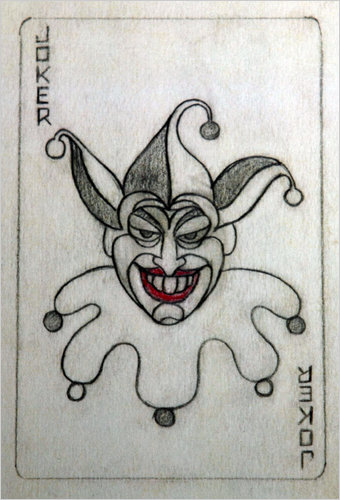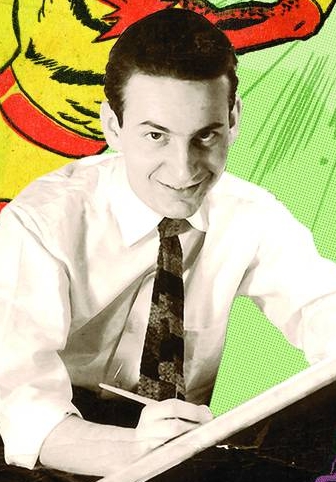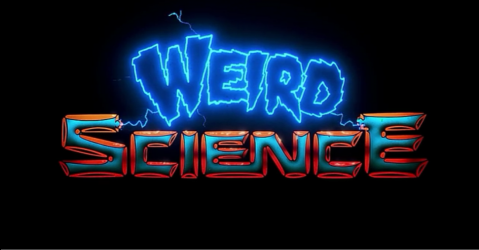
Welcome to a special installment of Those Who Came Before! It’s special because this will be the first time that we’ve gotten a chance to talk with our featured creator. That’s right, I had a conversation with one of the most influential men in the history of comics, Jerry Robinson.
Robinson died December 7, 2011, but I had the pleasure of talking with him a few months ago. Known for creating the Joker, his achievements stretch far beyond Gotham’s most famous criminal mastermind. During our chat he told stories of how he first got into comics, of a double date with one of the creators of Superman, and even the times he visited cartoonists in Russia’s gulags. So, let’s start at the beginning.
[Editors Note: At the bottom of this page is a link to the actual podcast interview available for download.]
A painter’s jacket
It was the summer of 1939, and 17-year-old Jerry Robinson was preparing to head off to college, pursuing a career in journalism and writing. He had been accepted at Columbia, Penn, and Syracuse. To earn some extra money for college, he took a summer job selling ice cream from a cart on the back of a bicycle. After a while, all of that pedaling had withered him away to just 98 pounds, and his mom was worried. She didn’t think he’d last the first semester at college, so she persuaded him to take $25 of his hard earned ice cream money, go to a resort, and fatten up.
It was at this resort in the Poconos where his path to comics began. He had never heard of comic books, though he was a cartoonist for his school newspaper. So, his first day at this resort he headed out to the tennis court to warm up, wearing a painter’s jacket that he had decorated with cartoons, which was the fad at the time.
“I was on the tennis team, so I ran out at this resort the first day, I used a painter’s jacket. I used it as a warm-up jacket for tennis. Bob just happened to walk by the court and spotted the jacket and tapped me on the shoulder and asked who did the drawings. I thought I was going to be arrested, and I didn’t even turn around. I said meekly… ‘I did.’ He said ‘They’re pretty good.’ We got to talking….”
That tap on the shoulder came from Batman co-creator Bob Kane, who was taking a week off after finishing up Detective Comics #27. Kane didn’t play tennis, but just happened to be walking by at that moment. Right there, Kane offered Robinson a job on Batman. The rest is quite literally comic history. Thank you, Mrs. Robinson!
That was the beginning of a life long journey for Jerry Robinson. Having already decided on Syracuse, he quickly switched to Columbia so that he could accept this job in New York. Less than a year later, the Joker was born in Batman #1. The year was 1940, and Jerry Robinson’s mark on comic history was cemented.

Back in the early forties, comics were taking off. Superman, Batman, and several other titles were burning up newsstand shelves. However, that didn’t make much of a positive impact on the professional art community. Robinson was interested in illustration of all types, and he tried to get additional work at magazines and book publishers.
“I soon found that I couldn’t get a job when I said that I was drawing Batman or drawing comics. I couldn’t even get an appointment with the art director….”
It was very tough in those days being a comic artist. Comic books were still pretty new, and not widely respected. So the problem wasn’t the quality of his work. Undeterred, Robinson did eventually manage to get some illustrating jobs. He just had to omit the fact that he drew comics. When he would submit samples of his work, it would be cutouts from panels that didn’t include any dialog or comic characters. Thankfully, the profession has come to garner the respect that it always deserved.
Comics under attack
Less than ten years after Robinson entered comics, the medium found itself under attack. It was the late forties and a man named Dr. Fredric Wertham was leading the charge. Over the next few years there were congressional hearings, comic book burnings, bans, and all sorts of commotion about comics supposedly being connected to, if not directly responsible for, the corruption of America’s youth. At the time, there were some notable creators who were rattled, and doubted the medium would survive this assault. Robinson, however, was not among them. When asked about it he said, “We were un-rattled!”
“We weren’t doing that kind of material that came under the spotlight of the committees and hearings and Wertham. As did the weird and the gory stuff that some of the other publishers were doing. But I, like most of the others, thought that it was way overblown. They tried to pin a whole problem of juvenile delinquency on reading comics. Which is nonsense.”
You mean there was a psychiatrist in the forties and fifties spewing nonsense…who knew?!?
Comics and kids
Have you been reading comics since your childhood? Many of us have, and it has served us well. It helped me to progress as a reader when I was younger, and it has even broadened my vocabulary.
However, there are parents who won’t buy their children a comic book. As you might imagine, Robinson has some thoughts on kids and comics. I asked what his response would be to the question, “Why should I let my child read comic books?”
“First of all, it’s a good tool to encourage reading. Somebody who starts out reading comics, they can progress to other forms of fiction and more traditional authors. So I’d say it’s a great teaching tool for kids to learn. Comics are really the novels of today…comics are one part of our culture.”
You hear that kids, make sure to read all of those thought bubbles and narration boxes.
I remember learning one of my SAT vocabulary words from a comic book. If it hadn’t been for Galactus’s gnawing hunger, I might never have seen the word assuage.
The Dark Knight
A character familiar to most any kid who reads comics is Bruce Wayne’s caped alter ego. A fair amount of Batman’s supporting cast can trace their roots back to Robinson, who played a major role in developing several Gotham mainstays. The first two that come to mind have to be the Joker and Robin. There were others as well, such as the Penguin, Two-Face, and Alfred.
Joker
The Joker was created by a 17-year-old Robinson who a year prior had never heard of comic books. I was curious about how it feels to see the Joker used by other artists over the years.
“I’m very appreciative about that, and flattered. Each one has their own take on the character, and sees some ingredient that they have brought to life. In the films as well as the books.”
Batman definitely has the best rogues gallery, and it all starts with the Joker. I heard it said once that the Joker is like all of Batman’s other great villains rolled into one. I’d agree with that, and if you believe that a hero is only as strong as his greatest villain, then Jerry Robinson could definitely look at Bruce Wayne with a sense of pride.
Though he hasn’t looked like this in a long time, the image below is the original sketch done by Robinson for the Joker. Even 70 years ago, there was something in the eyes.

Robin
Some have thought that Robinson named Batman’s young sidekick after himself. Robinson, Robin…not a big leap really, though it is a bit off the mark.
“I was only 18 at the time…. So I wouldn’t have been so presumptuous to name the character after myself. So, but it came from Robin Hood. I had been given a beautiful illustrated book of Robin Hood when I was about 10 or 12 years old. All the stories of Robin Hood, and I read those over and over again.”
Robinson not only named Robin, but designed his costume as well. Inspiration for Dick Grayson’s original outift came, again, from Robin Hood.
“N.C. Wyeth, he did these beautiful illustrations, and illustrated that book. And I still have it. When it came to Robin, I poured over those illustrations for so long, I was able to adapt from memory Robin’s costume inspired by one of Wyeth’s paintings of Robin Hood.
Nowadays it seems that plenty of comic characters have an appellation attached to them. Batman, the caped crusader, has plenty, the Joker is the clown prince of crime, and so on. Robin got his early on, the boy wonder. Robinson didn’t come up with that one, it was Bill Finger, a man who contributed as much as, or perhaps more than, anybody to the Batman mythos.
“…He added the appellation Robin the ‘Boy Wonder’ to my name. He used to kid me that I was ‘Robinson the Boy Wonder.’ You might think that that’s praise, but at that time I hated it. Because you know, when you’re 17 and 18, and you’re working with guys in their mid twenties, I thought they were so much older, at the time. 17 to 25 was a big gap, so I wanted to be seen as older. So, they called me Boy Wonder, I hated it. Now you can call me the Boy Wonder and I wouldn’t mind.”
The Joker and Robin have continued to be among DC’s most popular characters. Dick Grayson and Tim Drake have gone on to become great characters in their own right, progressing from sidekick status to successful heroes.
The history of comics
In addition to being a creator, Robinson was also a comic historian. He has published a few books on the subject, including one last year. Having studied and written about the comic strip, originating decades before the first comic book was published, and personally witnessing most of the history of the comic book firsthand, he was in a unique position. Remember, Robinson met Bob Kane in late 1939, just over a year after Superman was introduced to the world in Action Comics #1. I asked him what he sees as the single most important development in the history of comic books.
“Well, I guess you’d have to go back to the introduction of Superman, which started the whole genre of the superhero. That was a big radical departure from the kind of things that were being produced even in the early comic books. And that as you know, you see what happened to the superhero over the years. That was, I think, the most radical thing that was introduced into comics. It was quite different from what was printed…as I said the comic book grew out of the comic strip. And Siegel and Shuster submitted Superman to all the top newspaper syndicates of the time, and were rejected. They thought it was too wild, too weird, too unbelievable. … So, the inception of comic books made the big difference.”
Jerry Robinson definitely made a huge mark on the history of this medium. His list of accomplishments and contributions is a long one. When looking over his career, you could pick out any one of several high points that most people would be proud to have as their proudest achievement. And Robinson has tons of them. So, which is he most proud of? Is it his work on Batman? His time as president of the National Cartoonists Society? Maybe his tenure in the same position at the Association of American Editorial Cartoonists? Nope, it was something else entirely, something selfless and heroic.
Working for others
So, looking back at his career and life in comics, what was Jerry Robinson most proud of?
“Well, I’d probably say my efforts on behalf of Siegel and Shuster. They were close friends of mine, I was doing Batman when they were doing Superman. And Joe [Shuster] worked at the next…literally abutting my own table at DC. That’s when we became friends, and we even double dated one time. So they were lifelong friends of mine. When I heard about the tragedy, you know which is really one of the great tragedies in modern times…the creators of one of the biggest properties of the 20th century were literally destitute.”
Thats right, it wasn’t until 1975 that DC Comics finally gave Joe Shuster & Jerry Siegel credit and compensation for their work. Without Superman, would DC even exist? That’s probably not a hard one to answer, and Robinson’s efforts, along with Neal Adams, to rally industry support produced results.
So, the next time you pick up a Superman book, and you see the “Superman created by Jerry Siegel & Joe Shuster” credit inside, you’ll know that one of their best friends helped get it there.
Robinson’s hard work on behalf of cartoonists doesn’t end there. There’s the artist in Uruguay whose freedom he helped secure after three years of torturous imprisonment.
Perhaps my favorite of all of his adventures are Robinson’s visits to Russia. As was the trend at the time, people who spoke out against the regime were treated very poorly. As it turned out, being a political cartoonist in Russia could land you in prison, especially if the people in power didn’t like your work. So, what did Jerry Robinson do? The persecuted cartoonists somehow got their work smuggled out to Robinson, who got it published. Then, he smuggled money back to them in Russia, in his money belt. Yes, that was very dangerous. Smuggling money to a target of state persecution in Russia was a very dangerous thing to do, especially for an American during the cold war.
Sounds like Jerry was one tough son of a gun.
It became obvious to me that for Jerry Robinson, making a positive difference in the lives of other people is what he was most proud of.
I can’t tell you all what a pleasure it was to speak with Jerry Robinson about his life in comics. He racked up enough living to fill three or four lives! He has been called the Ambassador of Comics, and I think that is a fitting title. In fact, I can’t think of anyone more deserving of such a role.
Please, use the links below to listen to the interview, and be sure to go over to his site for more examples of his work, comic and otherwise.
Further reading & listening
Download the full audio of the interview | Jerry Robinson Art
Eli Anthony
eli@comicattack.net



This was an incredible conversation. Well done, Eli. And thank you, Mr. Robinson, for all that you did for us fans. May you rest in peace!
Wow, you know you were meant for something big when you just happen to bump into Bob Kane accidentally, then wind up writing on one of the best books ever, and creating the best villain ever. Great stuff Eli!
Great write up, Eli!
Thanks guys, it was a real thrill to talk with him.
He really was one of the all time greats, who genuinely loved comics and sequential storytelling.
Amazing!